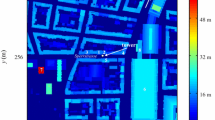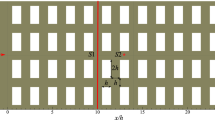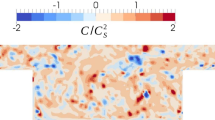Abstract
As urbanization progresses, more realistic methods are required to analyze the urban microclimate. However, given the complexity and computational cost of numerical models, the effects of realistic representations should be evaluated to identify the level of detail required for an accurate analysis. We consider the realistic representation of surface heating in an idealized three-dimensional urban configuration, and evaluate the spatial variability of flow statistics (mean flow and turbulent fluxes) in urban streets. Large-eddy simulations coupled with an urban energy balance model are employed, and the heating distribution of urban surfaces is parametrized using sets of horizontal and vertical Richardson numbers, characterizing thermal stratification and heating orientation with respect to the wind direction. For all studied conditions, the thermal field is strongly affected by the orientation of heating with respect to the airflow. The modification of airflow by the horizontal heating is also pronounced for strongly unstable conditions. The formation of the canyon vortices is affected by the three-dimensional heating distribution in both spanwise and streamwise street canyons, such that the secondary vortex is seen adjacent to the windward wall. For the dispersion field, however, the overall heating of urban surfaces, and more importantly, the vertical temperature gradient, dominate the distribution of concentration and the removal of pollutants from the building canyon. Accordingly, the spatial variability of concentration is not significantly affected by the detailed heating distribution. The analysis is extended to assess the effects of three-dimensional surface heating on turbulent transfer. Quadrant analysis reveals that the differential heating also affects the dominance of ejection and sweep events and the efficiency of turbulent transfer (exuberance) within the street canyon and at the roof level, while the vertical variation of these parameters is less dependent on the detailed heating of urban facets.











Similar content being viewed by others
References
Allegrini J, Dorer V, Carmeliet J (2013) Wind tunnel measurements of buoyant flows in street canyons. Build Environ 59:315–326
Antonia R (1981) Conditional sampling in turbulence measurement. Annu Rev Fluid Mech 13(1):131–156
ASHRAE AS (2004) Standard 90.1-2004, energy standard for buildings except low rise residential buildings. American Society of Heating, Refrigerating and Air-Conditioning Engineers, Inc., New York
Brown DF (1997) An improved methodology for characterizing atmospheric boundary layer turbulence and dispersion. PhD thesis, University of Illinois
Cai XM (2012) Effects of wall heating on flow characteristics in a street canyon. Boundary-Layer Meteorol 142(3):443–467
Cheng W, Liu CH (2011) Large-eddy simulation of turbulent transports in urban street canyons in different thermal stabilities. J Wind Eng Ind Aerodyn 99(4):434–442
Christen A, van Gorsel E, Vogt R (2007) Coherent structures in urban roughness sublayer turbulence. Int J Climatol 27(14):1955–1968
Coceal O, Thomas TG, Castro IP, Belcher SE (2006) Mean flow and turbulence statistics over groups of urban-like cubical obstacles. Boundary-Layer Meteorol 121(3):491–519
Coceal O, Dobre A, Thomas TG (2007a) Unsteady dynamics and organized structures from DNS over an idealized building canopy. Int J Climatol 27(14):1943–1953
Coceal O, Thomas TG, Belcher SE (2007b) Spatial variability of flow statistics within regular building arrays. Boundary-Layer Meteorol 125(3):537–552
Deardorff JW (1980) Stratocumulus-capped mixed layers derived from a three-dimensional model. Boundary-Layer Meteorol 18(4):495–527
Gousseau P, Blocken B, Stathopoulos T, Van Heijst G (2011) CFD simulation of near-field pollutant dispersion on a high-resolution grid: a case study by LES and RANS for a building group in downtown montreal. Atmos Environ 45(2):428–438
Hillel D (1982) Introduction to soil physics. Academic, New York, pp 364
Inagaki A, Castillo MCL, Yamashita Y, Kanda M, Takimoto H (2012) Large-eddy simulation of coherent flow structures within a cubical canopy. Boundary-Layer Meteorol 142(2):207–222
Kim JJ, Baik JJ (1999) A numerical study of thermal effects on flow and pollutant dispersion in urban street canyons. J Appl Meteorol 38(9):1249–1261
Kim JJ, Baik JJ (2001) Urban street-canyon flows with bottom heating. Atmos Environ 35(20):3395–3404
Kovar-Panskus A, Moulinneuf L, Savory E, Abdelqari A, Sini JF, Rosant JM, Robins A, Toy N (2002) A wind tunnel investigation of the influence of solar-induced wall-heating on the flow regime within a simulated urban street canyon. Water Air Soil Pollut 2(5–6):555–571
Krayenhoff ES, Voogt JA (2007) A microscale three-dimensional urban energy balance model for studying surface temperatures. Boundary-Layer Meteorol 123(3):433–461
Letzel MO, Krane M, Raasch S (2008) High resolution urban large-eddy simulation studies from street canyon to neighbourhood scale. Atmos Environ 42(38):8770–8784
Li XX, Britter RE, Koh TY, Norford LK, Liu CH, Entekhabi D, Leung DY (2010) Large-eddy simulation of flow and pollutant transport in urban street canyons with ground heating. Boundary-Layer Meteorol 137(2):187–204
Maronga B, Gryschka M, Heinze R, Hoffmann F, Kanani-Sühring F, Keck M, Ketelsen K, Letzel M, Sühring M, Raasch S (2015) The parallelized large-eddy simulation model (PALM) version 4.0 for atmospheric and oceanic flows: model formulation, recent developments, and future perspectives. Geosci Model Dev Discuss 8(2015), Nr 2, S 1539–1637
Meroney RN, Pavageau M, Rafailidis S, Schatzmann M (1996) Study of line source characteristics for 2-D physical modelling of pollutant dispersion in street canyons. J Wind Eng Ind Aerodyn 62(1):37–56
Michioka T, Sato A, Takimoto H, Kanda M (2011) Large-eddy simulation for the mechanism of pollutant removal from a two-dimensional street canyon. Boundary-Layer Meteorol 138(2):195–213
Nakamura Y, Oke TR (1988) Wind, temperature and stability conditions in an east–west oriented urban canyon. Atmos Environ (1967) 22(12):2691–2700
Nazarian N, Kleissl J (2015) CFD simulation of an idealized urban environment: thermal effects of geometrical characteristics and surface materials. Urban Clim 12:141–159
Nazarian N, Kleissl J (2016) Realistic solar heating in urban areas: air exchange and street-canyon ventilation. Build Environ 95:75–93
Park SB, Baik JJ, Raasch S, Letzel MO (2012) A large-eddy simulation study of thermal effects on turbulent flow and dispersion in and above a street canyon. J Appl Meteorol Clim 51(5):829–841
Pedersen C, Liesen R, Strand R, Fisher D, Dong L, Ellis P (2001) A toolkit for building load calculations; exterior heat balance. American Society of Heating, Refrigerating and Air-Conditioning Engineers, Inc. (ASHRAE), Building Systems Laboratory, New York
Piacsek SA, Williams GP (1970) Conservation properties of convection difference schemes. J Comput Phys 6(3):392–405
Qu Y, Milliez M, Musson-Genon L, Carissimo B (2012) Numerical study of the thermal effects of buildings on low-speed airflow taking into account 3D atmospheric radiation in urban canopy. J Wind Eng Ind Aerodyn 104:474–483
Raasch S, Schröter M (2001) PALM-a large-eddy simulation model performing on massively parallel computers. Meteorol Z 10(5):363–372
Raupach MR, Thom AS (1981) Turbulence in and above plant canopies. Annu Rev Fluid Mech 13(1):97–129
Raupach MR, Shaw RH (1982) Averaging procedures for flow within vegetation canopies. Boundary-Layer Meteorol 22(1):79–90
Salim SM, Buccolieri R, Chan A, Di Sabatino S (2011) Numerical simulation of atmospheric pollutant dispersion in an urban street canyon: Comparison between RANS and LES. J Wind Eng Ind Aerodyn 99(2):103–113
Salizzoni P, Soulhac L, Mejean P (2009) Street canyon ventilation and atmospheric turbulence. Atmos Environ 43(32):5056–5067
Santiago J, Krayenhoff E, Martilli A (2014) Flow simulations for simplified urban configurations with microscale distributions of surface thermal forcing. Urban Clim 9:115–133
Shaw RH, Tavangar J, Ward DP (1983) Structure of the Reynolds stress in a canopy layer. J Appl Meteorol Clim 22(11):1922–1931
Sini JF, Anquetin S, Mestayer PG (1996) Pollutant dispersion and thermal effects in urban street canyons. Atmos Environ 30(15):2659–2677
Stewart ID, Oke TR (2012) Local climate zones for urban temperature studies. Bull Am Meteorol Soc 93(12):1879–1900
Tan Z, Dong J, Xiao Y, Tu J (2015) A numerical study of diurnally varying surface temperature on flow patterns and pollutant dispersion in street canyons. Atmos Environ 104:217–227
Uehara K, Murakami S, Oikawa S, Wakamatsu S (2000) Wind tunnel experiments on how thermal stratification affects flow in and above urban street canyons. Atmos Environ 34(10):1553–1562
Wallace JM, Eckelmann H, Brodkey RS (1972) The wall region in turbulent shear flow. J Fluid Mech 54(01):39–48
Willmarth W, Lu S (1972) Structure of the Reynolds stress near the wall. J Fluid Mech 55(01):65–92
Xie ZT, Castro IP (2009) Large-eddy simulation for flow and dispersion in urban streets. Atmos Environ 43(13):2174–2185
Xie X, Liu CH, Leung DY, Leung MK (2006) Characteristics of air exchange in a street canyon with ground heating. Atmos Environ 40(33):6396–6409
Xie X, Liu CH, Leung DY (2007) Impact of building facades and ground heating on wind flow and pollutant transport in street canyons. Atmos Environ 41(39):9030–9049
Yaghoobian N, Kleissl J (2012) An indoor-outdoor building energy simulator to study urban modification effects on building energy use-model description and validation. Energy Build 54:407–417
Yaghoobian N, Kleissl J, Paw UKT (2014) An improved three-dimensional simulation of the diurnally varying street-canyon flow. Boundary-Layer Meteorol 153(2):251–276
Zmeureanu R, Fazio P, Haghighat F (1987) Analytical and inter-program validation of a building thermal model. Energy Build 10(2):121–133
Acknowledgements
We thank Omduth Coceal from University of Reading for providing the data of the DNS analysis used in this paper. Funding was received from the National Science Foundation, Environmental Sustainability CAREER award number CBET-0847054, as well as from the National Research Foundation Singapore under its Campus for Research Excellence and Technological Enterprise programme.
Author information
Authors and Affiliations
Corresponding author
Appendices
Appendix 1: Supplementary Information on Model Validation
The energy balance model (TUF-IOBES) by Yaghoobian and Kleissl (2012) was validated by comparing the change of modelled interior wall temperature in response to a step change in outside air temperature with an analytical solution as well as other models. The difference between the analytical solution and the TUF-IOBES model was less than 2.3% which was lower than other numerical models, including the 5% difference reported for the CBS-MASS model (Zmeureanu et al. 1987).
Left: vertical profile of exuberance [\(Exu=(S_1+S_3)/(S_2+S_4)\)]. Right: joint probability density functions calculated for current LES results and compared with the DNS of Coceal et al. (2007a) for neutral conditions
The PALM model for unstable flow in the urban canopy was validated by Park et al. (2012) against the wind-tunnel measurements of Uehara et al. (2000). The agreement in the vertical profiles of the normalized streamwise horizontal velocity and temperature supported the validity of the temperature wall function in the PALM model. The normalized scalar concentration simulated using the PALM model was successfully validated against wind-tunnel data of Meroney et al. (1996) with \(R^2=0.97\).
The coupling of the TUF-IOBES and PALM models was validated against data from the wind-tunnel experiment of Kovar-Panskus et al. (2002) for a two-dimensional street canyon with a heated windward wall, and also compared with the LES results of Cai (2012). Both numerical studies showed that based on mass conservation (downward mass flux into the canyon near the windward wall equals the upward mass flux out of the canyon near the leeward wall) the primary vortex should be shifted to the right which is different from the sketch provided by Kovar-Panskus et al. (2002) and rendered this portion of the experimental data questionable. The agreement with the Cai (2012) numerical simulation is encouraging.
Here, the quadrant analysis obtained by LES are compared with DNS of aligned arrays of cubes at \(Re_\mathrm{H}=5800\) for a neutral case performed by Coceal et al. (2007a). The DNS data are gathered every 0.005 s at heights 0.5H and 1.5H for 100T, where \(T=H/u_\tau \), and \(u_\tau \) is the friction velocity. LES results are outputted at various locations every \(3\,{\mathrm{s}}\) for a period of \(8\,{\mathrm{h}}\), therefore the number of data points are similar for the comparison. Grid resolutions relative to H are similar with 32 and 30 grid points per H for DNS and LES runs, respectively. Figure 12 shows close agreement in the shape of the quadrants, the frequency of events, as well as the value of exuberance at heights 0.5H and 1.5H at the centre of the canyon.
Appendix 2: Supplementary Information on Simulation Set-Up
This section describes the simulation set-up in more detail. Radiative and material properties of urban surfaces are shown in Table 2, which represents an example of a typical post-1980 building in a compact low-rise zone, with painted walls and roof, and asphalt/dry-soil street covers. The physical building set-up and thermal properties are chosen similar to Yaghoobian and Kleissl (2012) based on the construction materials that satisfy insulation requirements for non-residential buildings in ASHRAE 90.1-2004 (ASHRAE 2004). Buildings have square footprints of 21.3 \(\times \) 21.3 m\(^2\), and each wall of the buildings has a window centred on the wall with dimensions of \(12.2(\mathrm{height})\times 15.2(\mathrm{width})\, \mathrm{m}^2\), resulting in a window fraction of 0.47. Total domain height is 7.4H, where H is the building height (18.3 m).
In the TUF-IOBES model, the outdoor surface energy balance consists of net longwave radiation, \(L_{net}\), net shortwave radiation, \(S_{net}\) (accounting for multiple reflections of direct solar radiation and shading), conduction, \(Q_\mathrm{c}\), and convection, \(Q_\mathrm{h}\), that are solved and enforced for each outdoor patch surface. Latent heat fluxes are assumed to be zero. Direct and diffuse horizontal solar radiation is based on the TMY3 forcing data. Downwelling longwave radiation from the sky is based on Browns sky model (1997) as implemented in the ASHRAE Toolkit (2001), where \(L_{net}\) is a function of the air and dew point temperatures, cloud cover, and cloud height. The transient heat conduction is solved based on the z-transform method utilizing conduction transfer functions, and the diffusion equation by Hillel (1982) is solved to obtain a sinusoidal temperature boundary condition at the surface with a constant temperature boundary condition at soil depth. The surface convective heat fluxes are simulated based on the temperature differences between surfaces and canopy air, multiplied by a convective heat transfer coefficient based on an empirical model known as the DOE-2 method. Further information on the model, including fenestration model and forcing data can be found in Yaghoobian and Kleissl (2012) and Krayenhoff and Voogt (2007).
Appendix 3: Supplementary Analysis on the Three-Dimensional Flow Field
The effect of three-dimensional configuration and realistic surface heating in the streamwise canyon can be better understood by investigating the flow in the spanwise direction. In the absence of surface heating, several factors distinguish the roughness flow in three-dimensional aligned arrays compared to two-dimensional street canyons (Coceal et al. 2007a): (1) In the building canyon (BC, \(z<H\)), formation of two symmetric counter-rotating vortices is seen in the \(x-y\) plane where the vortex size and its centre varies with height. (2) Due to the structure of counter-rotating vortices, the canyon vortex in the \(x-z\) plane is smaller and the centre of the vortex is moved upward compared to the mid-height position in two-dimensional canyons (also shown in Fig. 5). (3) Due to the canopy-top shear layer, small eddies are shed off at the building edge into the streamwise canyon and above the building height.
The presence of surface heating further modifies the flow structure. For brevity, only the opposing condition is discussed here for different stability levels (Fig. 13). In the near-neutral case of \(U_\mathrm{b}=3\,\mathrm{m}\,{\mathrm{s}}^{-1}\), the size of two counter-rotating vortices in the \(x-y\) plane is as large as the canyon width, although their symmetry is influenced (indicated by the increased momentum entering the canyon from the south) by the temperature difference between north and south walls in the street canyon. In the highly unstable case, however, the two counter-rotating vortices in the \(x-y\) plane shrink and occupy only half of the street-canyon region close to the leeward wall, and the vortex shed off at the building edge to the streamwise canyon is increased. This is due to the formation of the secondary vortex adjacent to the windward wall, and the increased velocity gradient at the edges of the building canyon. Additionally, the ground heating at the street canyon forces more flow in the building canyon, and enhances downward velocity in the \(y-z\) plane for \(U_\mathrm{b}=0.5\,{\mathrm{m}}\,{\mathrm{s}}^{-1}\). Subsequently, the region of low momentum above the building height is more pronounced for the opposing condition (not shown). Both temperature and concentration fields are modified by the flow structure in the building canyon and higher values are seen compared to the street canyon. \(T^+\) and \(C^+\) are more concentrated close to the ground and the leeward wall, and asymmetry due to differential heating in the street canyon is seen in the \(x-y\) plane.
Rights and permissions
About this article
Cite this article
Nazarian, N., Martilli, A. & Kleissl, J. Impacts of Realistic Urban Heating, Part I: Spatial Variability of Mean Flow, Turbulent Exchange and Pollutant Dispersion. Boundary-Layer Meteorol 166, 367–393 (2018). https://doi.org/10.1007/s10546-017-0311-9
Received:
Accepted:
Published:
Issue Date:
DOI: https://doi.org/10.1007/s10546-017-0311-9






